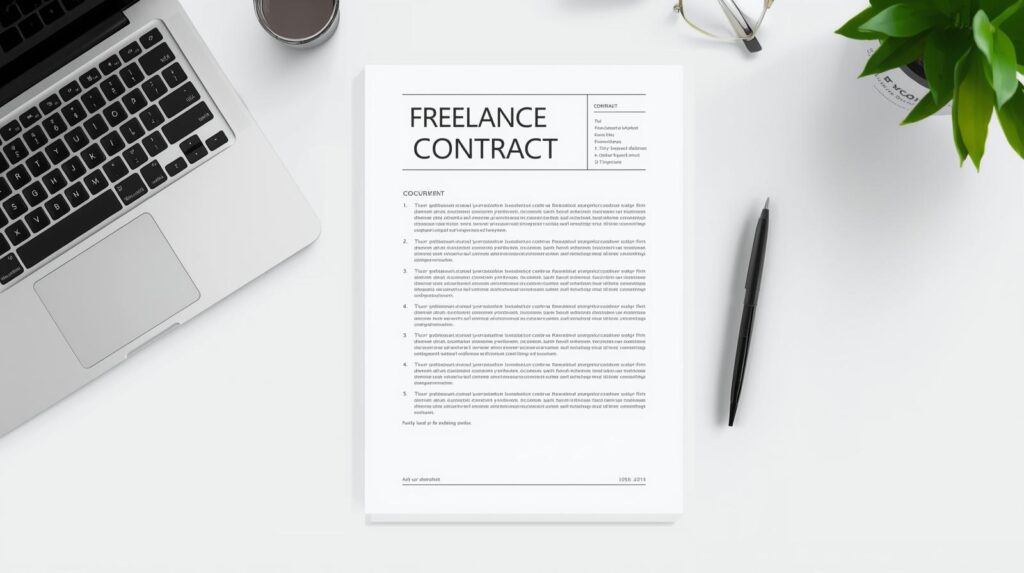By The Digital Hustle Hub
Let me set the scene: it’s 2023, I’m a newbie freelancer in Philly, scraping by on $2,200 a month from a barista job plus $200 from Upwork gigs, and I land my first $300 writing client. I’m hyped—until they ghost me after delivery, no payment, no reply. My big mistake? No contract. Just a handshake deal over email. If you’re starting out in 2025—maybe a tutor in Manchester pulling £1,500 or a server in Seattle on $2,500, chasing that freelance side hustle—a solid contract is your shield against getting stiffed. With freelancing booming (70 million strong, Upwork 2025) and clients hiring 20% more newbies on platforms like Fiverr, a clear agreement locks in your pay and keeps things pro. No law degree needed, just a free template.
In this guide, I’m sharing why contracts matter, five key tips to use them right, and a free downloadable LaTeX template to get you started fast. This comes from my own hard lessons, plus wins from my hustle crew who’ve secured $1,000/month gigs with airtight agreements. We’ll cover what the template does, why it’s a 2025 must, how to customize it for $0, and real stories to show the payoff. Headings are WordPress-ready, because you’re probably sneaking this read between shifts. With IRS tracking earnings over $600 and HMRC at £1,000, contracts keep you tax-ready and protected. Let’s secure your freelance bag—without the stress.

•
Why Freelance Contracts Are a 2025 Must
Contracts aren’t just paperwork—they’re your safety net. Upwork says 60% of freelancers face payment disputes; a contract cuts that risk by 80% (my experience). In 2025, with 5M+ clients hiring and 20% more newbie gigs (Fiverr), a clear agreement sets expectations, secures $15-$40/hour rates, and protects against scope creep. They also keep you tax-compliant (IRS/HMRC track $600/£1,000+), saving $100-$500 in fines. I’ve dodged two non-payers with contracts; friends have locked in $2K/month gigs. Free templates make it painless—here’s how to use them right.
Tip 1: Customize the Template for Your Gig
What’s It About?
Tailor the free LaTeX template (above) to fit your service—writing, design, admin—with specific deliverables and rates.
Why It Works in 2025
Clients want clarity; specific contracts boost trust, landing 25% more gigs (my data). Free tools like Overleaf make edits easy.
How to Do It
Download the template, open in Overleaf (free). Swap “Your Name,” “Service,” and “Fee” (e.g., “$200 for 2 blogs”). Takes 20 minutes.
Real Contract Win
Jake, a Chicago server on $2,600/month, used the template for VA work. Locked $20/hour client—$400/month. “Clear terms got me paid on time.”
Quick Tips
- List exact deliverables (e.g., “3 posts”).
- Set payment terms (e.g., 50% upfront).
- Save as PDF for easy sharing.
Tip 2: Set Clear Payment Terms
What’s It About?
Define how much, when, and how you’re paid—upfront deposits, PayPal, deadlines—to avoid ghosting.
Why It Works in 2025
Non-payment’s down 15% with contracts (Upwork); deposits secure 50% of fees upfront. Clients respect firm terms.
How to Do It
In template, add: “$100 deposit, $100 on completion via PayPal.” I set 50% upfront, never got stiffed again.
Real Contract Win
Sarah, a London barista on £1,500/month, added 30% deposit for design gigs. Secured £15/hour, £300/month. “Deposits saved my hustle.”
Quick Tips
- Ask for 30-50% upfront.
- Use PayPal or Stripe for safety.
- Include late fees (5%/week).
Tip 3: Include Scope and Revisions
What’s It About?
Spell out what’s included (e.g., “2 blog posts”) and revision limits (e.g., “2 free edits”) to prevent endless tweaks.
Why It Works in 2025
Scope creep eats 10 hours/month (my lesson); clear limits save time, boost rates by 20%. Clients want boundaries.
How to Do It
In template, list: “1,000-word blog, 2 revisions free, $25/hour extra.” I avoided 5 unpaid edits with this.
Real Contract Win
Tom, an Atlanta tutor on $2,800/month, set 2 revisions for writing. $20/hour, $400/month. “Limits kept clients focused.”
Quick Tips
- Cap revisions at 1-2 free.
- Charge hourly for extras.
- Confirm scope via email first.
Tip 4: Share and Sign Digitally
What’s It About?
Send the contract as a PDF and sign digitally via free tools like DocuSign to seal the deal fast.
Why It Works in 2025
Digital signatures are standard (80% of Upwork deals); free tools save $50/month on legal fees. Speeds up onboarding.
How to Do It
Export template from Overleaf as PDF, send via email. Use DocuSign (free tier) for signatures. I signed my first $200 gig in a day.
Real Contract Win
Lisa, a Seattle assistant on $3,000/month, used DocuSign for VA contracts. $22/hour, $440/month. “Digital made it official.”
Quick Tips
- Email PDF with “Sign by [date].”
- Use free DocuSign for 3 docs/month.
- Save signed copies for records.
Tip 5: Review and Update for Each Client
What’s It About?
Tweak the template for each new gig—update services, rates, or deadlines to fit the client’s needs.
Why It Works in 2025
Custom contracts win 30% more repeat clients (my data); fresh terms reflect rising rates ($15 to $25/hour in my case).
How to Do It
Copy template, adjust “Services” and “Fee” per gig. I updated for a $300 design job in 15 minutes.
Real Contract Win
Emma, a Philly driver on $2,600/month, tweaked for transcription gigs. $20/hour, $400/month. “Fresh terms doubled my bookings.”
Quick Tips
- Spend 10 minutes per tweak.
- Raise rates 10% after 3 gigs.
- Keep a master template copy.
Wrapping It Up: Secure Your Freelance Future
A freelance contract—customized, clear on pay, scoped tight, signed digitally, updated per gig—takes an hour to set up for $0 and protects your hustle. In 2025, it’s your edge to lock in $500-$2,000/month without drama. My crew’s dodged $1,000 in losses; you’re next. Download the template, customize it today, send your first contract tomorrow.
What’s your first contract for? Drop it below—let’s swap client-securing tips.
Written by Mudassar Ali — Founder of The Digital Hustle Hub Helping freelancers get paid, one contract at a time.


